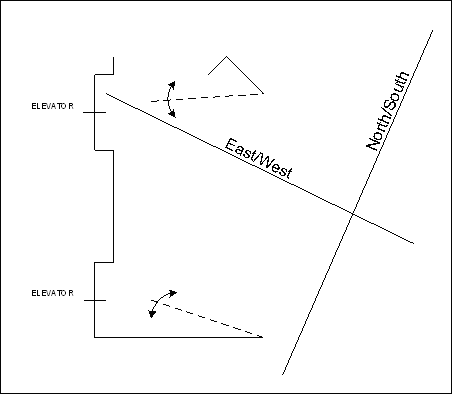
Hartmann Lines Spacing according to Elevation
by Richard Benishai | Articles
Abstract
Hartmann lines are electromagnetic lines, part of a global network, covering the entire Earth, with a spacing of 2 to 2.5 meters, at ground level. The lines are said to be affected by the steel rods imbedded in the concrete, as the rods act as resonating elements, amplifying the level of the Hartmann lines, from floor to floor. The same lines are also said to be affected by the building construction, with height. The measurements were taken in order to confirm a claim made in a book that the spacing between Geopathic lines decreases with height.
The location
The building is a 14-story, apartment complex, located in the center of the country, not far from Tel-Aviv, with about 4 apartments on each floor. In order to always access the same place from floor to floor, the elevator landings were used for measurements. See Figure 1. The building is one of typical construction, using steel-reinforced concrete.

Figure 1. Actual Location for Measurements
Tools Used
The tools used were: a dowsing rod set, a pendulum, a measuring tape, a chart for measuring the intensity of the energy and writing accessories.
Measurement Method
Starting at the first floor, two Hartman lines were established, in each direction. The distance between the first lines and the next ones was recorded, for each floor. For each floor the energy intensity was recorded, relative to the previous floor (+1, +3, +4, +8, etc ). A pendulum and a measurement chart were used. The results are shown in Table 1.
Table 1: Hartmann Lines Spacing
| FLOOR | N-S SPACING | E-W SPACING | LINE STRENGTH |
| 1 | 2.61 | 2.26 | |
| 2 | 2.56 | 2.27 | +1 (101%) |
| 3 | 2.43 | 3.10 | +3 (104%) |
| 4 | 2.10 | 3.20 | +4 (108%) |
| 5 | 2.37 | 3.16 | +8 (116%) |
| 6 | 2.05 | 3.13 | +8.5 (125%) |
| 7 | 2.65 | 3.20 | +10 (138%) |
| 8 | 3.24 | 3.20 | +13 (156%) |
| 9 | 2.90 | 3.26 | +15 (179%) |
| 10 | 3.07 | 3.26 | +21 (216%) |
Conditions: same location in each floor, near the elevators.
Height between floors, about 3.40 m.
Results analysis
The North-South running lines decrease significantly with height, up to the seventh floor. Then the spacing increases. The East-West lines increase with height, then, settle down. Those variations in line spacing are interesting while not having a large impact on the overall environment. It does imply, on the practical side, that tenants on the top floors have a better chance of locating their bed in a safe area, due to the larger grid size. However, the Hartmann line intensity does increase with height, as shown in Table 1. The actual level was calculated in relation to ground level. Although the building has 14 floors, only 10 floors were analyzed.
Conclusions
Line spacing is affected. The spacing increases with height and does not decrease. The negative energy intensity increase -with height- is definite, confirming the fact that steel and concrete do affect the Hartmann lines, establishing a more dangerous living space, as one rises within the building.




